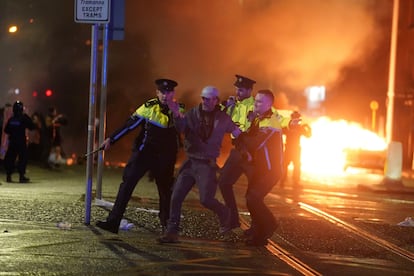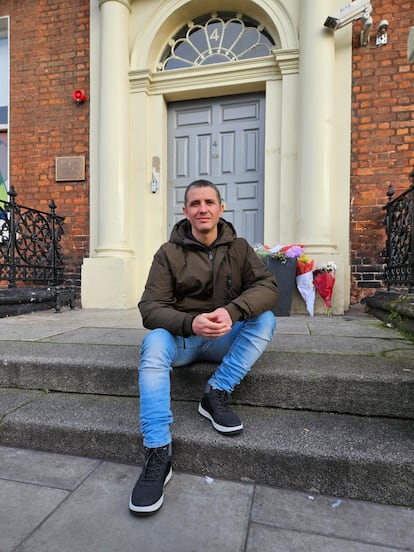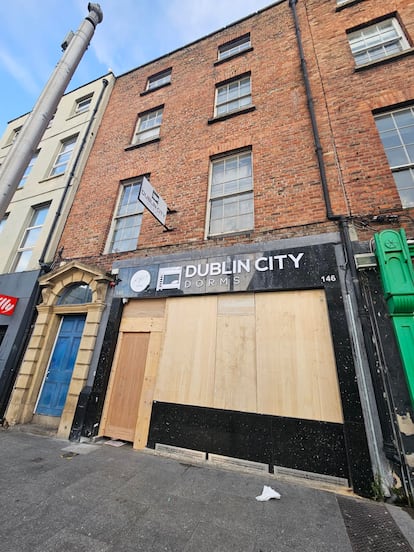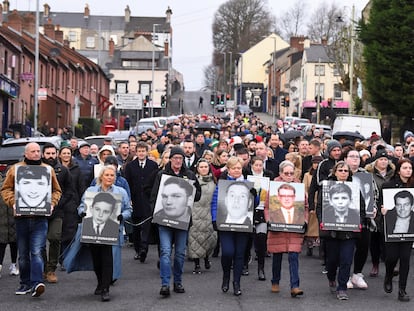Ireland grapples with xenophobic violence of the extreme right
Far-right racist groups have burst onto the streets of Dublin. In one recent event, a delivery driver managed to catch a criminal who stabbed three children and a woman. He explains to EL PAÍS how it all happened

In recent days, Ireland has desperately needed a moral boost to lift itself out of its misery. After the night of street violence, burning vehicles, broken windows and racist and xenophobic slogans that hit the center of Dublin this past Thursday, November 23, most of the Irish have clung to Caio Benicio, 43, who hails from Brazil. Born in Rio de Janeiro, he’s been a delivery driver in Dublin for the past year.
“I don’t see myself as a hero, no matter how much people repeat it. I also have two children. Anyone would have done what I did. When you see a big man, with a big knife, who’s attacking a girl… it doesn’t occur to you if you’re an immigrant, or if he’s an immigrant. You’re simply a human being who decides to act. It’s an instinct: you don’t consider whether it’s dangerous or not,” Benicio explains to EL PAÍS. In such a painful week, he has received much applause in the country.

At 1:40 p.m. local time on Thursday, a man armed with a knife spread terror in Parnell Square, in the center of Dublin. The students from the Gaelscoil Choláiste Mhuire primary school were exiting the building. He stabbed three children and a teacher who tried to defend them. Of the victims, a five-year-old girl and the woman remain hospitalized in critical condition.
Benicio dropped his motorcycle on the ground and hit the aggressor with his helmet. He knocked him down immediately and managed to get the knife away… although not before the man had already inflicted several stab wounds on himself. He remains hospitalized and in police custody.
“I hit him again when he was already on the ground. Immediately, a lot of people approached and started kicking him. He didn’t move at all. Someone took the girl away from there,” Benicio explains in front of the school door, adorning his story with gestures. “From then on, I only remember bright flashes. I saw three ladies who were trying to protect him, because if not, I’m afraid [the crowd] would have ended up killing him,” the Brazilian sighs.
The news spread on social media instantly. The rage of those present turned into anger and fury, as hundreds of far-right fanatics took to the streets. There was a rumor — never confirmed by the police — that the attacker was a foreigner. Some identified him as Algerian.
“Everyone city center tonight 7pm no excuses everyone out enough is enough,” wrote anti-immigration activist Gavin Pepper on X (formerly Twitter). He is one of the most active far-right figures in Ireland. He subsequently deleted his message… but the fuse was already lit. “They won’t be able to control us all. Let’s break up into small groups and do what we have to do. At seven, everyone on the street. Well-equipped. Any fucking foreigner you see, kill them. Kill them all,” said a voice message on Telegram, from an account calling itself Kill All Immigrants. Security journalist Conor Gallagher reported this in The Irish Times.
Within this context, Caio Benicio is the hope that many are clinging to, as they try to convince their fellow citizens not to fall into doubt amidst a wave of immigration in Ireland and throughout Europe. He’s a symbol of not losing the human side of the crisis.
Racism and street crime
The center of Dublin was filled with chants against immigrants on Thursday night. Some groups of protesters attempted to hunt down refugees sleeping in accommodations across Ireland. There are about 73,000 currently in the country, with more than 50,000 from Ukraine. The doors and windows of the Dublin City Dorms (a residential building) were covered with wooden panels: no immigrant had slept there for months, but the assailants tried to enter the building.

Most of the rioters, however, were more concerned about burning cars, police vehicles, buses and tram cars… and grabbing a good pair of sneakers, after smashing the windows at Foot Locker. Several specialized clothing stores were covered with protective panels by the weekend.
“The windows of that [convenience store] were also smashed,” a woman points out. She runs an Oxfam second-hand bookshop, where proceeds go towards charitable purposes. “They were only interested in cigarettes and chocolate,” she laughs with relief, hoping that the worst is over.
Hundreds of police have been deployed across the city center to prevent a repetition of riots that, the government admits, have been the worst-ever recorded in Ireland, at least since 2006. The Garda — as the forces of order are known (“Guardians of Peace,” in Irish) — wasn’t prepared for such enormous violence. Several of its officers suffered attacks and injuries. It took a lot of work to control the 200 or 300 rioters who were bent on destroying everything in their path.
“The threat from the extreme-right and xenophobic movements has been there for at least two years. It has worsened with the arrival of refugees from Ukraine… the messages of hate that have been spread on social media have skyrocketed,” says Peter Farrelly, the campaign coordinator for one of the legislators from the center-right Fine Gael, one of the three main Irish political parties. “But there’s a second factor that has caused everything to overflow. There’s increasing decay in Dublin One.” This inner-city northern district — despite being increasingly trendy — suffers from serious security problems. “There’s massive drug consumption in [full public view] and a considerable increase in crime. [Some people from this area] — the ones who have nothing to lose — have combined their forces with the extreme-right to raze the city,” he points out.
This explanation is a double consolation for many. Not only is it easier to blame thugs for violence and riots: it also serves to preserve the image of Ireland as a tolerant, welcoming country. The signals that reality emits, however, are more worrying. Last year, almost 150,000 foreigners arrived in Ireland, a country of five million people that has serious problems with housing and public services. They may be a minority, but the ultra-right fans who walk the streets of Dublin with signs demanding “Houses for Irish” make sure that they can’t move freely. EL PAÍS was able to see one of these extremists chasing and harassing two local journalists, recording them on his mobile phone and accusing them of protecting the perpetrator of the girl’s stabbing. Later, alongside another group of extremists, he gloated while posting the video on social media.
“The police immediately told us to seek protection [on Thursday] and I hid. Today, I feel comfortable again, but I admit that I was scared,” explains Promise Enofe. Of Nigerian descent, he has been in Ireland for 20 years. He works in public, soliciting donations and subscriptions for the humanitarian organization ActionAid. Near him, there are several agents patrolling the commercial streets.
“I feel very safe in Dublin. Remember, I come from Rio de Janeiro,” Benicio jokes. “I know many Irish people who have treated me very well. There’s a small group of people who hate immigrants… but I don’t think [this sentiment] can be generalized.”
Today, many Irish people are relying on the Brazilian’s optimism. However, the government has already announced that it will toughen the laws against hate crimes and strengthen the capacity of the police. What happened this past week in the center of Dublin, everyone admits, is a warning sign that must be addressed.
Sign up for our weekly newsletter to get more English-language news coverage from EL PAÍS USA Edition
Tu suscripción se está usando en otro dispositivo
¿Quieres añadir otro usuario a tu suscripción?
Si continúas leyendo en este dispositivo, no se podrá leer en el otro.
FlechaTu suscripción se está usando en otro dispositivo y solo puedes acceder a EL PAÍS desde un dispositivo a la vez.
Si quieres compartir tu cuenta, cambia tu suscripción a la modalidad Premium, así podrás añadir otro usuario. Cada uno accederá con su propia cuenta de email, lo que os permitirá personalizar vuestra experiencia en EL PAÍS.
¿Tienes una suscripción de empresa? Accede aquí para contratar más cuentas.
En el caso de no saber quién está usando tu cuenta, te recomendamos cambiar tu contraseña aquí.
Si decides continuar compartiendo tu cuenta, este mensaje se mostrará en tu dispositivo y en el de la otra persona que está usando tu cuenta de forma indefinida, afectando a tu experiencia de lectura. Puedes consultar aquí los términos y condiciones de la suscripción digital.
More information
Últimas noticias
Most viewed
- Reinhard Genzel, Nobel laureate in physics: ‘One-minute videos will never give you the truth’
- Oona Chaplin: ‘I told James Cameron that I was living in a treehouse and starting a permaculture project with a friend’
- Pablo Escobar’s hippos: A serious environmental problem, 40 years on
- Charles Dubouloz, mountaineering star, retires at 36 with a farewell tour inspired by Walter Bonatti
- Why we lost the habit of sleeping in two segments and how that changed our sense of time











































